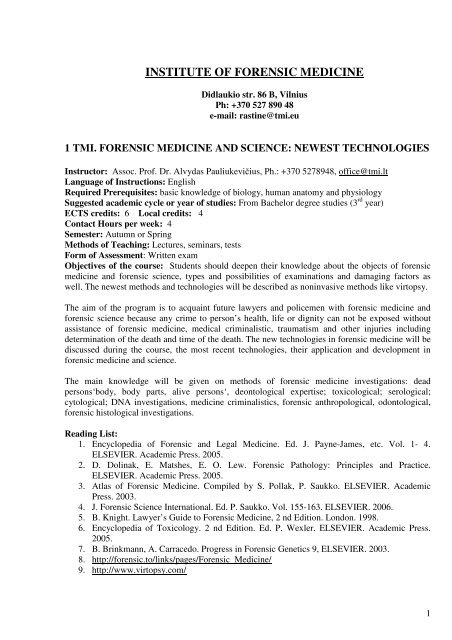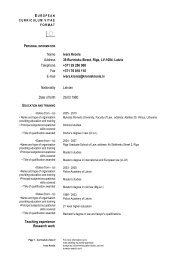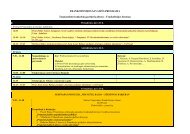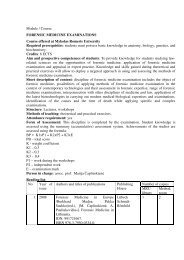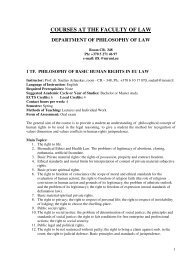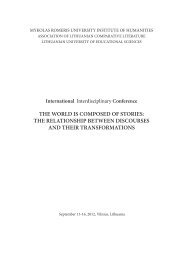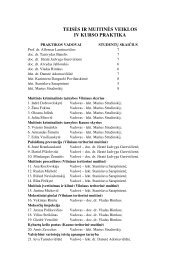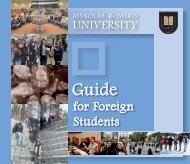INSTITUTE OF FORENSIC MEDICINE
INSTITUTE OF FORENSIC MEDICINE
INSTITUTE OF FORENSIC MEDICINE
You also want an ePaper? Increase the reach of your titles
YUMPU automatically turns print PDFs into web optimized ePapers that Google loves.
<strong>INSTITUTE</strong> <strong>OF</strong> <strong>FORENSIC</strong> <strong>MEDICINE</strong><br />
Didlaukio str. 86 B, Vilnius<br />
Ph: +370 527 890 48<br />
e-mail: rastine@tmi.eu<br />
1 TMI. <strong>FORENSIC</strong> <strong>MEDICINE</strong> AND SCIENCE: NEWEST TECHNOLOGIES<br />
Instructor: Assoc. Prof. Dr. Alvydas Pauliukevičius, Ph.: +370 5278948, office@tmi.lt<br />
Language of Instructions: English<br />
Required Prerequisites: basic knowledge of biology, human anatomy and physiology<br />
Suggested academic cycle or year of studies: From Bachelor degree studies (3 rd year)<br />
ECTS credits: 6 Local credits: 4<br />
Contact Hours per week: 4<br />
Semester: Autumn or Spring<br />
Methods of Teaching: Lectures, seminars, tests<br />
Form of Assessment: Written exam<br />
Objectives of the course: Students should deepen their knowledge about the objects of forensic<br />
medicine and forensic science, types and possibilities of examinations and damaging factors as<br />
well. The newest methods and technologies will be described as noninvasive methods like virtopsy.<br />
The aim of the program is to acquaint future lawyers and policemen with forensic medicine and<br />
forensic science because any crime to person’s health, life or dignity can not be exposed without<br />
assistance of forensic medicine, medical criminalistic, traumatism and other injuries including<br />
determination of the death and time of the death. The new technologies in forensic medicine will be<br />
discussed during the course, the most recent technologies, their application and development in<br />
forensic medicine and science.<br />
The main knowledge will be given on methods of forensic medicine investigations: dead<br />
persons‘body, body parts, alive persons‘, deontological expertise; toxicological; serological;<br />
cytological; DNA investigations, medicine criminalistics, forensic anthropological, odontological,<br />
forensic histological investigations.<br />
Reading List:<br />
1. Encyclopedia of Forensic and Legal Medicine. Ed. J. Payne-James, etc. Vol. 1- 4.<br />
ELSEVIER. Academic Press. 2005.<br />
2. D. Dolinak, E. Matshes, E. O. Lew. Forensic Pathology: Principles and Practice.<br />
ELSEVIER. Academic Press. 2005.<br />
3. Atlas of Forensic Medicine. Compiled by S. Pollak, P. Saukko. ELSEVIER. Academic<br />
Press. 2003.<br />
4. J. Forensic Science International. Ed. P. Saukko. Vol. 155-163. ELSEVIER. 2006.<br />
5. B. Knight. Lawyer’s Guide to Forensic Medicine, 2 nd Edition. London. 1998.<br />
6. Encyclopedia of Toxicology. 2 nd Edition. Ed. P. Wexler. ELSEVIER. Academic Press.<br />
2005.<br />
7. B. Brinkmann, A. Carracedo. Progress in Forensic Genetics 9, ELSEVIER. 2003.<br />
8. http://forensic.to/links/pages/Forensic_Medicine/<br />
9. http://www.virtopsy.com/<br />
1
2 TMI. <strong>FORENSIC</strong> ANTHROPOLOGY<br />
Instructor: Assoc.Prof.Dr. Rimantas Jankauskas, Ph.: +370 52789047, rimantas.jankauskas@tmi.lt<br />
Language of Instruction: English<br />
Required prerequisites: Human anatomy / osteology<br />
Suggested academic cycle or year of studies: From Bachelor degree studies (3rd year)<br />
ECTS credits: 4.5 Local credits: 3<br />
Contact Hours per week: 4<br />
Semester: Autumn or Spring<br />
Methods of Teaching: Seminars, handouts, labs<br />
Form of Assesssment: Oral examination<br />
The objective of the course is to provide essential knowledge on aims, objectives and methods of<br />
forensic anthropology. Following topics are covered: biology of skeletal tissues. Outline of human<br />
skeleton and it’s variations. Anatomy of teeth. Peculiarities of osteology of animals. Chronology of<br />
skeletal growth. Biology of senescence of skeleton. Factors of sexual dimorphism. Craniometric,<br />
osteometric and odontometric instruments. Preparation of human remains for anthropological<br />
analysis. Documentation. Determination of group identification traits. Macroscopic methods of age<br />
determination (dental eruption, epiphyseal union, morphology of symphysis, cranial susure<br />
obliteration, sternal end of ribs, degenerative changes of the skeleton, complec method).<br />
Histological methods of age determination. Methods of sex determination (pelvis and skull<br />
morphology, discriminant methods). Determination of ancestry according to skeleton and teeth.<br />
Determination of stature and other somatometric traits. Individual traits (pathology of the skeleton,<br />
traces of diseases, traumas and surgery, dental pathology and dental treatment. Principles of<br />
forensic facial reconstruction. Forensic archaeology: principles of investigation, instruments,<br />
documentation. Forensic anthropology of mass graves. Taphonomy of skeletal tissues: physical and<br />
chemical processes. Perimortal and postmortal changes. Changes of skeletal tissues at high<br />
temperatures and possibilities of identification. Supplementary methods: forensic entomology,<br />
zoology, palinology, geology. Principles of identification of living person. Professional<br />
organisations and publications of forensic anthropology.<br />
Reading list:<br />
1. Bass W. Human Osteology. Missouri Archaeological Society, 1971.<br />
2. Krogman W.M., Yasar Iscan, M. The Human Skeleton in Forensic Medicine. C.C. Thomas:<br />
1986.<br />
3. Ubelaker D. Human Skeletal Remains. 2 nd ed. Washington: Taraxacum, 1989.<br />
4. White T.D., Folkens P.A. Human Osteology. Academic Press, Inc.: 1991.<br />
5. Yasar Iscan M., Kennedy K (Eds.) Reconstruction of life from the skeleton. W.Liss: 1989.<br />
6. Knussmann R. Anthropologie. Handbuch der vergleichenden Biologie des Menschen.<br />
Stuttgart e.a., 1988.<br />
7. Death, decay and reconstruction: approaches to archaeology and forensic science. Ed. By A.<br />
Boddington, A.N. Garland, R.C. Janaway. Manchester University Press, 1987.<br />
8. Holck P. Cremated bones. Oslo: Antropologiske skrifter Nr.1, 1986.<br />
9. Garmus A. Lithuanian Forensic Osteology. Vilnius, 1996.<br />
10. Recommendations for Age and Sex Diagnoses of Skeletons. Journal of Human Evolution<br />
(1980) 9: 517-549.<br />
11. http://forensic.to/links/pages/Forensic_Medicine/Anthropology/<br />
2
3 TMI. CRIME AND DNA INVESTIGATION. NEW TECHNOLOGIES IN<br />
DNA <strong>FORENSIC</strong>S<br />
Instructor: Dr. Marija Čaplinskiene, Ph.: + 370 688 46832, m.caplinskiene@tmi.lt<br />
Language of Instructions: English<br />
Required Prerequisites: basic knowledge of biology<br />
Contact Hours per week: 4<br />
ECTS credits: 4, 5. Local credits: 3<br />
Semester: Autumn or spring<br />
Methods of Teaching: lectures, seminars<br />
Form of Assessment: written work, exam.<br />
The course discusses application aspects of the highly discriminatory DNA markers those could be<br />
used to resolve questions evidence source identification. Forensic DNA typing methods and<br />
technologies have been evolving rapidly. The examples of DNA uses for Forensic Identification<br />
will be discussed.<br />
• How does forensic identification work?<br />
• Is DNA effective in identifying persons?<br />
• How is DNA typing done?<br />
• What are some of the DNA technologies used in forensic investigations?<br />
• DNA Forensics Databases.<br />
• Ethical, Legal, and Social Concerns about DNA Data banking.<br />
• Potential Benefits of DNA Data banking Arrestees.<br />
The stain analysis – sources will be analyzed during the course.<br />
What are the Current possibilities of DNA laboratory? Future perspectives and newest technologies<br />
will be described.<br />
Casework Analysis:<br />
• Forensic identification.<br />
• Parentage testing.<br />
DNA chip technology.<br />
CODIS Laboratory.<br />
Reading List:<br />
1. J. M. Butler. Forensic DNA Typing: Biology, Technology, and Genetics of STR Markers.<br />
2 nd edition. ELSEVIER. Academic Press, London. 2005.<br />
2. B. Brinkmann, A. Carracedo. Progress in Forensic Genetics 9, ELSEVIER. 2003.<br />
3. R. Fridell. DNA Fingerprinting: The Ultimate Identity. London. 2001.<br />
4. R. Fridell. Solving Crimes: Pioneers of Forensic Science (Lives in Science). Grolier<br />
Publishing. Canada. 2000.<br />
5. J. W. Evett, S. Bruce Weir. Interpreting DNA Evidence: Statistical Genetics for Forensic<br />
Scientists. 2001.<br />
6. P. Sauko (Edit.), Forensic Science International. Elsevier. Vol. 136. 2003.<br />
7. D. Patzelt, M. P. Baur, J. Bertrams. Forensiche Serologie/Hamogenetik. Kapitel 11,<br />
Munster. 2004.<br />
8. W. Schuller, L. Fereday, R. Scheithauer. International Hanbook on DNA Data exchange and<br />
practice. Lyon. 2001.<br />
3
4 TMI. NEUROBIOLOGY <strong>OF</strong> HUMAN BEHAVIOR AND CRIME SCENES<br />
Instructor: Dr. Marija Čaplinskienė, Ph.: + 370 688 46832, m.caplinskiene@tmi.lt<br />
Language of Instructions: English<br />
Required Prerequisites: principles of biology, human anatomy, physiology<br />
Suggested academic cycle or year of studies: From Bachelor degree studies (3 rd year)<br />
ECTS credits: 4,5 Local credits: 3<br />
Contact Hours per week: 4<br />
Semester: Autumn or Spring<br />
Methods of Teaching: Lectures, seminars, individual work.<br />
Form of Assessment: written paper, exam<br />
Objectives of the course: The course discusses application aspects of the neurobiology of human<br />
behavior, the cases where person’s abnormality plays the most important causing both violence and<br />
suicide.<br />
To analyze the factors and prevalence rates of antisocial behavior in different countries and current<br />
trends related crime scenes. The prevalent role plays a situation causing an extreme frustration,<br />
which can cause suicide or violence. The situation can determine a reaction – aggression against<br />
himself or another one. There are the cases where person’s abnormality plays the most important<br />
causing both violence and suicide. Violent and suicidal behaviors are also linked to biological and<br />
genetic predisposition. The findings in association between low levels of neurotransmitters (like<br />
serotonin) in cerebrospinal fluid (CSF) and aggressive behavior are obvious.<br />
The following topics will be discussed during the course:<br />
• Principles of human behavior and cognitive neurology.<br />
• Antisocial behavior: direct analysis of candidate genes in impulsive behaviors.<br />
• Aggression from a developmental perspective: genes, environments and interactions.<br />
• Neurophysiology and neuropsychopharmacology.<br />
• Suicidal behavior in youth.<br />
• Neurobiological approaches to disorders of personality.<br />
• Studies on the possibility of a genetic basis for violence.<br />
• Association analysis of some molecular-genetic markers with criminal violence.<br />
• Research prevention programs.<br />
• Genetics and human behaviour: the ethical and legal context.<br />
Reading List:<br />
1. M.-M. Mesulam. Principles of Behavioral and Cognitive Neurology. 2nd Edition. Academic<br />
Prees, 2006.<br />
2. R. Ader. Psychoneuroimmunology. 4th Editon, vol. 1, 2. Academic Prees, 2006.<br />
3. Genetics and human behaviour: the ethical context. Nuffield Council on Bioethics, London.<br />
2002.<br />
4. M. Dolan. Neurobiological Approaches to Disorders of Personality. Manchester. 2002.<br />
5. National Institute of Mental Health. Suicide Research Program. Bethesda. 2002.<br />
6. K. I. Morley, W. D. Hall. Is there a genetic susceptibility to engage in criminal acts? Trends<br />
& Issues in crime and criminal justice. Canberra. 2003.<br />
7. D. Wasserman, R. Wachbroit (Eds.). Genetics and Criminal Behavior, Cambridge. 2001.<br />
8. S. H. Rhee, I. Waldman. Genetic and environmental influences on antisocial behavior: a<br />
meta-analysis of twin and adoption studies. Psychological Bulletin, vol. 128, no. 3.<br />
4
5 TMI. SUSTAINABLE DEVELOPMENT AND PUBLIC HEALTH POLICY<br />
MANAGEMENT<br />
Instructor: Dr. Marija Čaplinskienė, Ph.: + 370 68846832, m.caplinskiene@tmi.lt<br />
Language of Instructions: English<br />
Required Prerequisites: principles of biology, physiology<br />
Suggested academic cycle or year of studies: From Bachelor degree studies (3 rd year)<br />
ECTS credits: 4,5 Local credits:3<br />
Contact Hours per week:4<br />
Semester: Autumn or Spring<br />
Methods of Teaching: Lectures, seminars, handouts<br />
Form of Assessment: Written paper, exam<br />
Objectives of the course: Introduction to Public Health Policy and Sustainable Development,<br />
Legal Issues, Recommendations of World Health Organization, Research Data on Environment<br />
pollution and Public Health, Ecosystems damage, Disease Prevention Programs and action plans.<br />
The course discusses application aspects of principals of sustainable development and public health<br />
policy on national and international level, legal aspects and control, the risk management of public<br />
health and environment interaction, regulation principles. European environment and health<br />
strategy, EC public health care policy, ethical, legal issues on health privacy. Centre for Diseases<br />
Control (CDC, Atlanta) recommendations on Diseases Prevention and Education Programs<br />
implementation system. Mass disasters, biodiversities, prevention measures, tools and action plan.<br />
Data analyses of environment risk factors, ecosystems damage and public health, planning and<br />
management of prevention and education programs. Gaps and obstacles of public health and<br />
environment monitoring system. Current trends and future perspective in public health policy and<br />
legal issues. Innovation in examining models of development for achievements in reducing poverty<br />
and inequality, in raising quality of life, in enhancing the status of women, in advancing effective<br />
health care systems, and in conserving the biodiversity of fragile environments.<br />
Reading List:<br />
1. Report 2000-2002: Towards sustainable Development in Baltic Sea Region. Poland,<br />
Drukrnia MiSiuro. Baltic 21 Series No. 1/2003.<br />
2. Sustainable Development Strategies. A Resurse Book. The Int. Inst. For Environment and<br />
Development. Earthscan Publications Ltd. London. 2002.<br />
3. World Population Monitoring. United Nations. New York. 2001.<br />
4. Čaplinskienė M., Aggression from a developmental perspective: Genes, environments and<br />
interactions, The World Journal of Biological Psychiatry Volume 5, Supplement 1, ISSN<br />
1562-2975. 2004.<br />
5. Key Issues in Sustainable Development and Learning. A Critical Review. Edited by:<br />
William Scott, Stephen Gough, Bath University. 2003, p. 288.<br />
6. Dzemydienė D. Temporal Information Management and Decision Support for Predictive<br />
Control of Environment Contamination Processes. In: Advances in Databases and<br />
Information Systems. Proc. of Fifth East-European Conf. ADBIS'2001. J. Eder, A.<br />
Caplinskas (Eds.). Vol. 1. ISBN 9986-05-449-4. Vilnius. Technika. 2001, p. 157-172.<br />
7. Citizens and Governance for Sustainable Development: CIGSUD’2006. Ed.: W.L. Filho, D.<br />
Dzemydiene, etc. Vilnius. 2006.<br />
5


